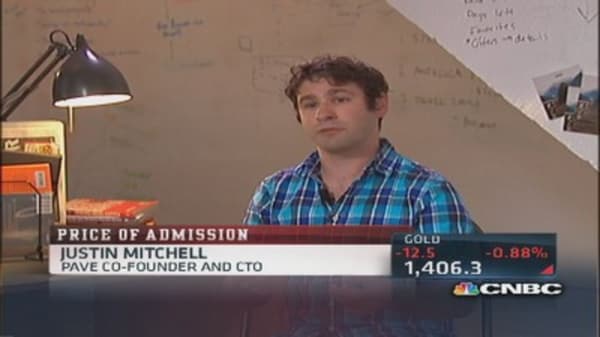With the cost of a college education increasing at a pace roughly double the pace of inflation, students are looking at new ways to pay for their degrees, cut the costs of classes in innovative ways and maximize alumni connections after graduation to jumpstart their careers.
Teaching online could cut the bottom line of a college education
Imagine being able to cut the cost of a college education by a third. The University at Albany, The State University of New York, said it might be possible using MOOCs—massive open online courses.
The SUNY System is one of a small but growing number of universities and university systems adding MOOCs to their course lineup. Online courses have been around for years, but improvements in interactive technology, a tech-savvy generation and a desire by schools to keep costs under control, all appear to be coming together to form an inflection point for their use.
Like the SUNY System, San Jose State University sees potential to reach more students using MOOCs.
"So right now we have a tremendous amount of trouble meeting a demand we have," said SJSU professor Ron Rogers. "And so these courses are a potential way for us to allow access to students."
(Read more: How to get the most out of your college savings)
The school recently completed a pilot program, offering five MOOCs through the online platform Udacity. The courses are designed and monitored by SJSU professors. They are open to far more students than a class taught on campus, so students will not have to wait a semester or two for a place in a required class, helping to keep them on track to graduate in four years. The classes also cost a lot less.
Incoming freshman Harriet Kansiime took a MOOC over the summer to fulfill a SJSU math requirement. It cost her $150, far less than the $1,700 it would have cost her to take it on campus.
"First of all, the cost of having to travel to San Jose State every day, that saved me a lot of money," Kansiime said of the gas savings. "And I was able to study at my own pace."
While MOOCs are traditionally free online, the colleges that are using, or experimenting with them, note there will be a cost if a student wants credit for taking these courses. Colleges will charge fees to transfer credits and the professors who monitor students and give tests need to be paid as well.
Right now, SJSU feels MOOCs are best used to teach courses in certain disciplines.
"I think courses in science, technology, math and engineering are easier initially to transition to this type of online setting," said Rogers. "But it really depends on the instructor, what they are willing to try and how innovative people want to be."
While critics say MOOCs cannot replace the traditional college experience, folding them into a curriculum means a college may be able to reach more of its own students, and others looking to take a class at a lower cost.
Finding a helping hand in a crowd
Eighty-five percent of Americans still find value in obtaining a college degree, according to a recent study by Sallie Mae, though families are contributing a smaller portion of their savings to paying for a child's higher education.
As a result, some students are looking for financial help from the crowd, or more specifically crowdfunding.
"I raised $20,000," said Jennifer Schoolcraft, a student at Roosevelt University. Schoolcraft will use the money to pay for her bachelor's degree in sociology, after which she plans to go to graduate school to become an occupational therapist.
"In exchange for that $20,000, after I graduate from school and am employed, a certain percentage of my income is taken out and gets delivered back to backers," said Schoolcraft.
Schoolcraft found her backers through Pave, an online crowdfunding platform linking investors with approved applicants. The investors are interested in putting their money to work in people, rather than products or companies, according to Pave co-founder Justin Mitchell.
With Pave, it's not a loan, it's an investment. The graduating students will always pay a percentage of their incomes for 10 years, regardless of their salaries. If the graduate lands a high-paying job, the investors may get back much more than they invested.
(Read more: Parents face the student loan double whammy)
"It's a brand-new idea and we didn't know what the uptake would be," Mitchell said of the December launch. "Roughly 4,000 prospects have expressed interest so far and perhaps 1,000 people have expressed interest in becoming a backer."
Here is how Pave works: A person submits an application telling their story and outlining why they need the money and how they will use it. Pave approves the application and puts it online for potential backers to see. The backers then decide if they want to invest, and how much they want to invest.
If the applicant is a student, six months after graduating they start returning a negotiated percentage of their income to the backers. The percentage will vary based on things such as loan size and the applicant's profession, though it can never exceed 10 percent of their income. The payments continue for 10 years.
"This aligns interests entirely between backers and prospects," said Mitchell. "The better a prospect does, the better a backer ends up doing."
If a prospect does really well, and they payback more than five times the original investment in less than 10 years, they can negotiate a release from the agreement. Pave does not expect this to happen often, instead estimating investors will likely receive annual returns ranging from 5 to 8 percent on their investment.
The risk for backers is that they might never get back all of their original investment.
Pave makes its money taking 3 percent of the original investment and charging an annual service fee of 1.5 percent. The company will work with the applicant over time to make sure they are able to, and are making the payments.
Founded in 2012, Pave has funded 19 people so far. Mitchell said roughly half of them are students looking to fund an education, or pay down student debt, suggesting in a time of skyrocketing tuition, it might take a crowd, not a village, to help a student get a college degree.
Angel alumni give wings to start-ups
Fidelity Investment's former investment whiz Peter Lynch, used to tell people, "invest in what you know." These days a growing number of alumni are doing just that, investing in companies started by students and graduates of their alma maters.
"If you go to college campuses nowadays it is remarkable the level of entrepreneurial activity happening there," said Pavan Nigam, co-founder of the medical website WebMD and currently the founding partner of the venture firm Inspovation Ventures.
He is also a graduate of the University of Wisconsin and the founder of the Silicon Valley Badgers, a group of Wisconsin alumni who mentor currents students and sometimes fund the students' ideas.
Nigam said the bond provided by a common college experience can be key to maintaining a good working relationship between an entrepreneur and their investors.





